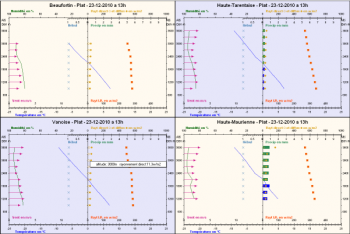SAFRAN
Système d’Analyse Fournissant des Renseignements Adaptés à la Nivologie
The objective analysis module SAFRAN (Durand et al, 1993) originally developed at CNRM/CEN for operational needs estimate avalanche hazard in mountainous areas, is a simple application particularly suited for viewing or initializing 1D models. It is also used operationally for hydrological monitoring and estimating rates throughout the metropolitan France. Its main features are the use of a non- regular grid and flexibility in the areas of analysis and observations used and the ability to run on small computer configurations. SAFRAN is also a tool for research and development which is the basis of many studies on the impact of climate and climate change.
The main feature of SAFRAN is the treatment of a limited area divided into non-scheduled areas. These basic areas of analysis also have a vertical dimension as well as several possible directions. The main constraint on the zoning is a certain spatial homogeneity of the analyzed quantities. It will be readily appreciated that the spatial resolution is well suited to the description of mountains and plains in many areas.
Input, SAFRAN uses meteorological fields from a draft or meteorological model reanalysis and many sources of observations, manual or automatic and various climatological fields.
The analyzed parameters are:
- temperature, wind , humidity near the surface and out of the boundary layer effects
- cloudiness ( partial 3 layers) , and precipitation phase.
- other parameters as direct and diffuse solar radiation or infrared radiation down are evaluated from previously analyzed variables.
The first method of analysis is an optimal interpolation every 6 hours (except for precipitation remain at this level in no 24h) with the draft model (or climatology for precipitation) and a largely manual observations as the outcome of the nivo-meteorological network. The hourly values are obtained by a second type variational analysis on these windows 6h using all available information, including that of automatic observation altitude, as well as related to the diurnal variation adjustment.
Output the analyzed variables are not time, with the main difficulty being in time estimation of rainfall and their phase is carried out in particular by the use of parameters present and past synoptic observations and the potential contribution radar observations.
References
Betout Paul, Durand Yves, Pailleux Jean. 1980 : Projet Améthyste, cahier n°4. Un schéma opérationnel d’analyse objective par interpolation optimale. Note technique EERM, n° 73 (nouvelle série), Juillet 1980.
Courtier Philippe. 1987 : Application du contrôle optimal à la prévision numérique en météorologie. Thèse de Doctorat de l’Université Paris 6, 27 Juin 87.
Courtier Philippe and others. 1993: The ECMWF implementation of three dimensional variational assimilation (3D-Var). Part 1: Formulation. Q. J. R. Meteorol. 123.
Durand Yves, Brun Eric, Mérindol Laurent, Guyomarc’h Gilbert, Lesaffre Bernard and Eric Martin. 1993: A meteorological estimation of relevant parameters for snow models, A. of Glaciol., 18, 65-71.
Rutherford. 1976 : An operational three-dimensional multivariate statistical objective analysis scheme. The GARP Program on numerical experimentation; rapport n° 11, Janvier 1976.




